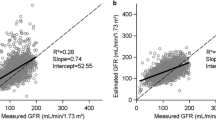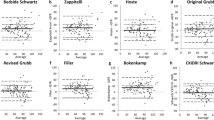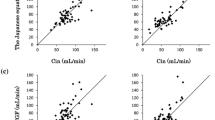Abstract
Background
Equations for the creatinine-based estimated glomerular filtration rate (eGFR) were recently established for Japanese adults (>18 years old) and children (2–11 years old), respectively, but it is unclear whether eGFR can be as useful as 24-h creatinine clearance (CCr) for assessing renal function in patients receiving chemotherapy. This study examined the degree of concordance between eGFR and CCr and the risk factors leading to the overestimation of renal function by eGFR.
Methods
A total of 53 data points of 19 children and 56 data points of 16 adults who received chemotherapy were analyzed retrospectively. Body mass index, serum creatinine concentration, 24-h urinary creatinine excretion (UCr), and nephrectomy were considered as risk factors for overestimation by eGFR.
Results
In the pediatric part of the study, 7 data points from 3 patients who underwent nephrectomy were included. The eGFR in patients with bilateral kidneys overestimated renal function to a greater degree than in patients with a unilateral kidney. In 45.7 % of pediatric patients with bilateral kidneys and in 19.6 % of adult patients, eGFR overestimated renal function. The risk factor for overestimation was lower UCr in pediatric patients with bilateral kidneys and adult patients.
Conclusions
Concordance between eGFR and CCr in pediatric patients with a unilateral kidney should be assessed separately from that in patients with bilateral kidneys. In restricting calculation of eGFR to pediatric patients with bilateral kidneys and adult patients without little muscle mass, eGFR may be useful regardless of whether patients are receiving chemotherapy.






Similar content being viewed by others
References
Launay-Vacher V, Oudard S, Janus N, et al. Prevalence of renal insufficiency in cancer patients and implications for anticancer drug management: the renal insufficiency and anticancer medications (IRMA) study. Cancer. 2007;110:1376–84.
Holweger K, Bokemeyer C, Lipp HP. Accurate measurement of individual glomerular filtration rate in cancer patients: an ongoing challenge. J Cancer Res Clin Oncol. 2005;131:559–67.
Barnard DR. Prevention and treatment of renal and urinary tract toxicity. In: Altman AJ, editor. Supportive care of children with cancer: current therapy and guidelines from the Children’s Oncology Group. 3rd ed. Baltimore: The Johns Hopkins University Press; 2004. p. 100–22.
Imai E, Horio M, Nitta K, et al. Estimation of glomerular filtration rate by the MDRD study equation modified for Japanese patients with chronic kidney disease. Clin Exp Nephrol. 2007;11:41–50.
Nagai T, Uemura O, Ishikura K, et al. Creatinine-based equations to estimate glomerular filtration rate in Japanese children aged between 2 and 11 years old with chronic kidney disease. Clin Exp Nephrol. 2013;17:877–81.
Blum D, Omlin A, Baracos VE, et al. Cancer cachexia: a systematic literature review of items and domains associated with involuntary weight loss in cancer. Crit Rev Oncol Hematol. 2011;80:114–44.
Hartlev LB, Boeje CR, Bluhme H, et al. Monitoring renal function during chemotherapy. Eur J Nucl Med Mol Imaging. 2012;39:1478–82.
The Japanese Society for Pediatric Endocrinology and the Japanese Association for Human Auxology. http://jspe.umin.jp/medical/taikaku.html. Accessed 21 Jan 2014.
Uemura O, Honda M, Matsuyama T, et al. Age, gender, and body length effects on reference serum creatinine levels determined by an enzymatic method in Japanese children: a multicenter study. Clin Exp Nephrol. 2011;15:694–9.
Moriyama M, Saito H, Kabuto M. Relationship between twenty-four hour urinary creatinine excretion and weight, or weight and height of Japanese children. J Nutr Sci Vitaminol (Tokyo). 1987;33:185–93.
Kawasaki T, Uezono K, Itoh K, Ueno M. Prediction of 24-hour urinary creatinine excretion from age, body weight and height of an individual and its application. Nihon Koshu Eisei Zasshi. 1991;38:567–74 (Article in Japanese, Abstract in English).
Blufpand HN, Tromp J, Abbink FC, et al. Cystatin C more accurately detects mildly impaired renal function than creatinine in children receiving treatment for malignancy. Pediatr Blood Cancer. 2011;57:262–7.
Hari P, Bagga A, Mahajan P, et al. Effect of malnutrition on serum creatinine and cystatin C levels. Pediatr Nephrol. 2007;22:1757–61.
Nakai K, Kikuchi M, Fujimoto K, et al. Serum levels of cystatin C in patients with malignancy. Clin Exp Nephrol. 2008;12:132–9.
Risch L, Herklotz R, Blumberg A, et al. Effects of glucocorticoid immunosuppression on serum cystatin C concentrations in renal transplant patients. Clin Chem. 2001;47:2055–9.
Conflict of interest
The authors have declared that no conflict of interest exists.
Author information
Authors and Affiliations
Corresponding author
About this article
Cite this article
Inoue, N., Watanabe, H., Okamura, K. et al. Are the equations for the creatinine-based estimated glomerular filtration rate applicable to the evaluation of renal function in Japanese children and adult patients receiving chemotherapy?. Clin Exp Nephrol 19, 298–308 (2015). https://doi.org/10.1007/s10157-014-0976-z
Received:
Accepted:
Published:
Issue Date:
DOI: https://doi.org/10.1007/s10157-014-0976-z




